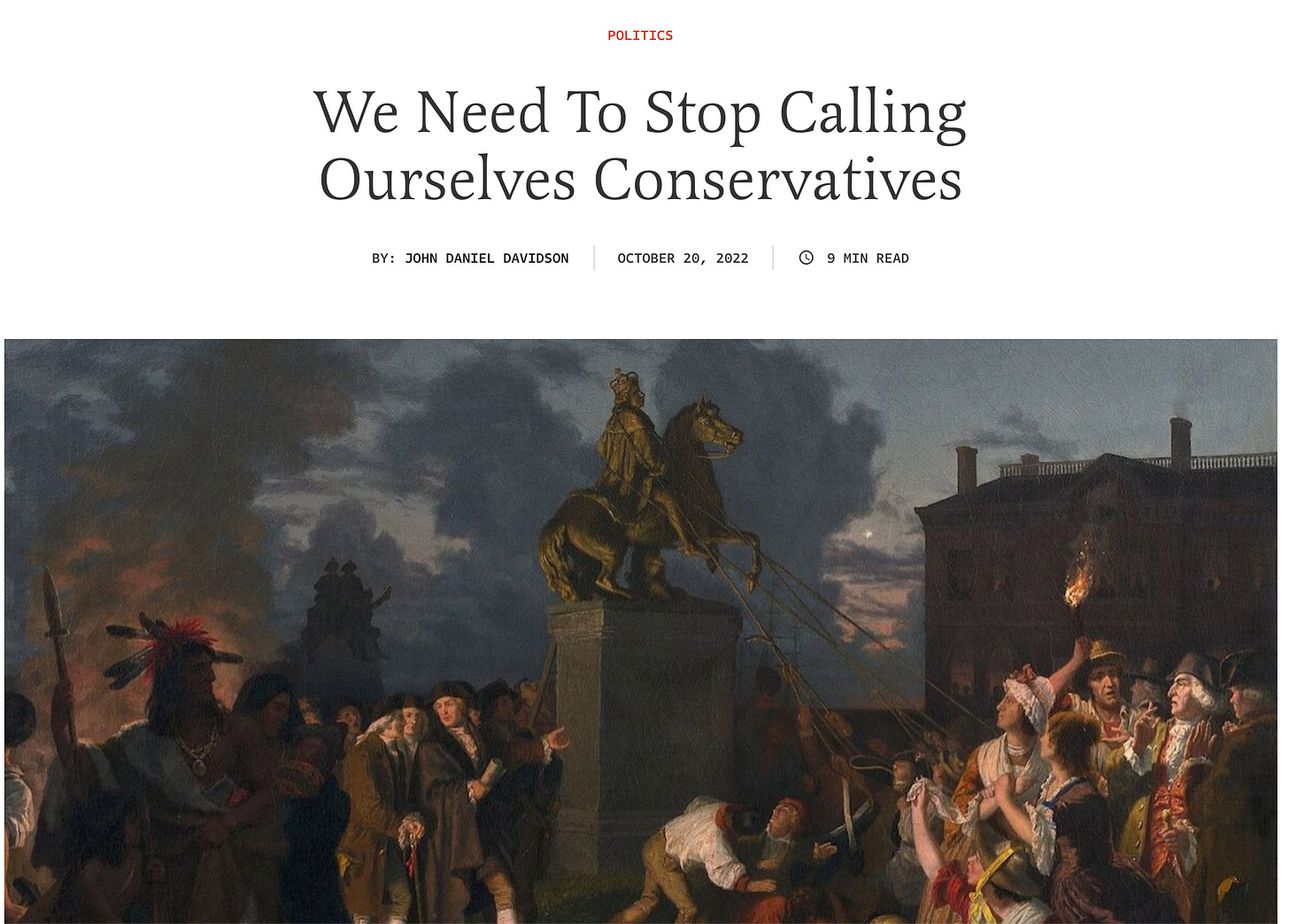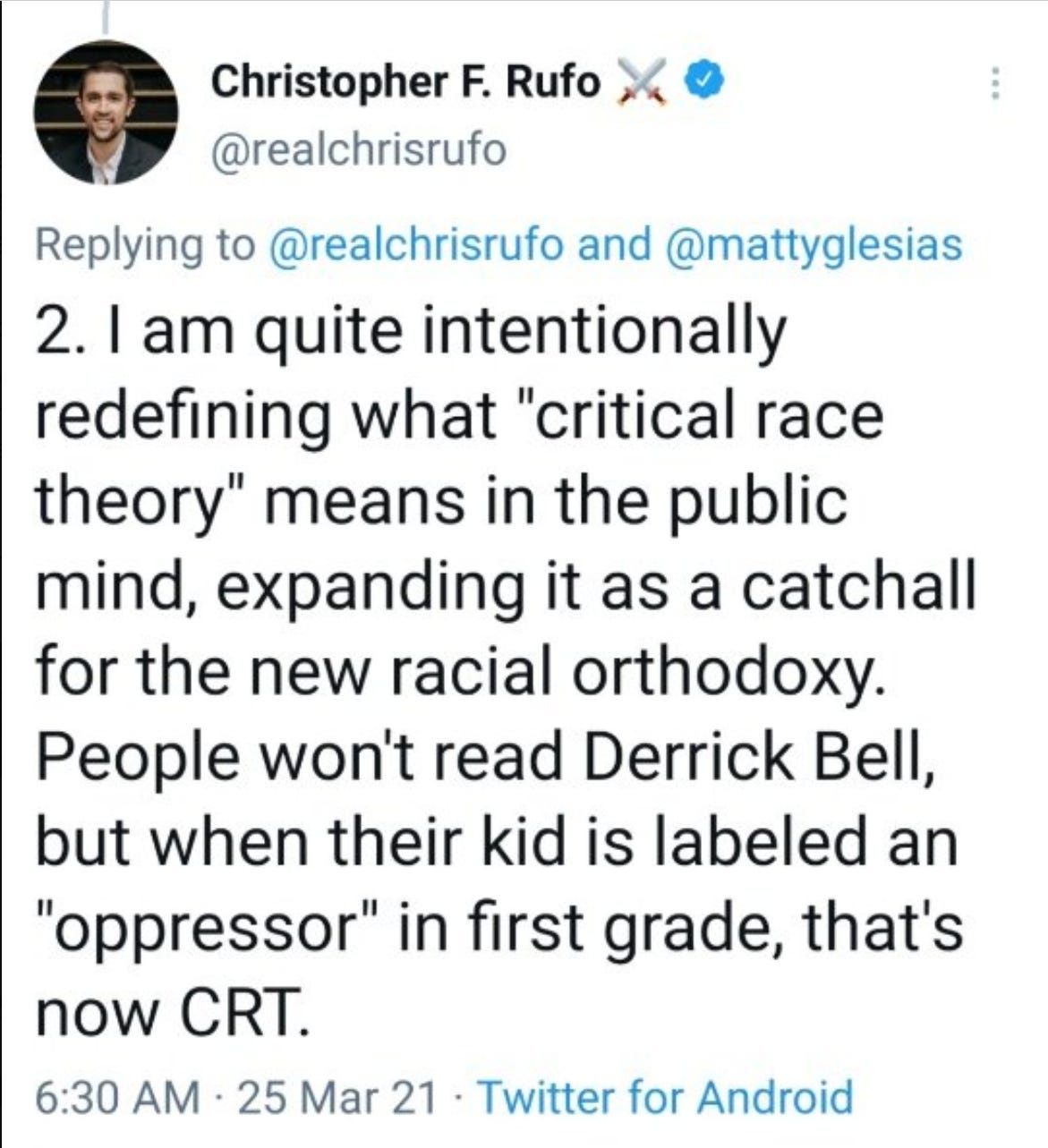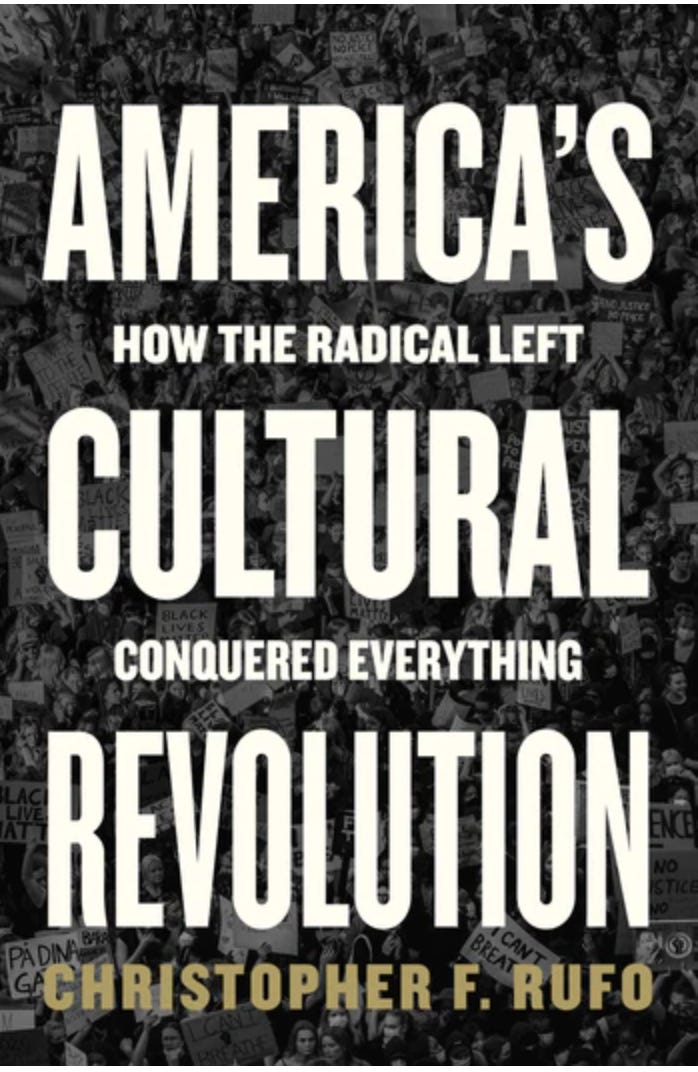Rightwing Dreams of American Reconquista
A counter-revolutionary zeal and desire for vengeance is what unites Donald Trump, Ron DeSantis, Christopher Rufo, Nate Hochman, and the rest of today’s Right
It is time to stand up to the Supreme Court. Time to push back against justices who use judicial review to legislate from the bench, to “judges who interpret the law and Constitution based on their personal beliefs rather than in accordance with its settled meaning and on the basis of objective principles.” We must no longer defer to those on the Court who seem to act from a sense of “legislative omnipotence” – must not allow the Court to act as if it was operating in a vacuum.
This urgent plea for judicial restraint was formulated by none other than Ronald Dion DeSantis, who devoted three whole chapters (chapters 18-20) of his largely forgotten 2011 book Dreams From Our Founding Fathers to the question of how to bring a rogue Supreme Court back in line.
In the book, DeSantis seeks to present himself as a “constitutional conservative” who respects the “first principles” the Framers supposedly sought to enshrine in the country’s founding documents: A commitment to small-government and free-market libertarianism – a desire to restrain governmental power, to keep the state out of people’s private lives and from interfering with private business. Barack Obama, on the other hand, is presented as the antithesis to these principles – a demagogue who doesn’t care about the constitution or individual liberty, whose goal it is to expand the power of the state to the point where it not only regulates even the most private, intimate affairs of formerly free citizens, but is enabled to radically redistribute wealth from top to bottom, from white to Black.
Two weeks ago, I wrote almost 4,000 words on why this book is interesting as a manifestation of the Tea Party moment in Republican politics, as a window into the ways in which reactionaries use and abuse history, and as a stepping stone for exploring the Right’s recent intellectual and political trajectory. What I didn’t talk about was DeSantis’ take on the Supreme Court. It is worth revisiting these passages, as they help reveal something crucial about the way today’s Right thinks about itself, the state, and the major institutions of American life – and about how rightwingers intend to use them to impose their vision on the entire country.
The Right is united behind the Dobbs Court
DeSantis’ scathing critique of judicial overreach was directed at what he perceived to be a Supreme Court dominated by liberals. Unsurprisingly, he focused his ire on the two justices Obama had nominated – Sonia Sotomayor had joined SCOTUS in August 2009, Elana Kagan followed a year later. DeSantis was particularly enraged because the Court hadn’t immediately struck down the entirety of Obamacare, which DeSantis presented as the centerpiece of Obama’s devious plan to rob Americans of their freedom.
DeSantis’ assertion that the Supreme Court in 2011 was serving as an instrument to realize Obama’s dream of transforming America into a statist dictatorship is rather bizarre. Remember, the “swing vote” in this Court was Anthony Kennedy, who had been nominated by Ronald Reagan in 1988 and agreed to retire in 2018 so that Donald Trump could replace him with Brett Kavanaugh. Hardly the profile of a radical leftist. By the time DeSantis wrote his book, the Kennedy Court had already decided Citizens United in 2010; it would soon go on to drastically hollow out the 1965 Voting Rights Act in Shelby County v Holder in 2013.
From the perspective of 2023, it is a strange experience reading such a “constitutional conservative” critique of the Supreme Court. Everything DeSantis declared dangerous and unconstitutional so obviously applies to the reactionary majority today. The Dobbs Court is what Ron DeSantis claimed to fear and abhor in 2011: No consistent logic or principle beyond ideologically driven power politics; justices acting as all-powerful rulers clad in robes, believing themselves free to reign outside the structure of institutions that make up the political system. And yet, the entire Right is fully on board – if there is still a principled critique based on “constitutional conservatism,” no one of any significance within the Republican Party or the Right more broadly cares. At all.
Here is something that is as banal and self-evident as it is crucial: The difference between conservatives lamenting an “activist” Court and rightwingers applauding the wannabe-rulers in robes comes down, first and foremost, to power. A Court (supposedly) in the hands of Liberals is bad and needs to be restraint; a Court fully controlled by the Right and acting as the spearhead of the reactionary attempt to roll back the past century of racial and social progress is good and must be cheered on.
But there is more to be learned here. Power needs to be justified – if nothing else, we all have to give ourselves permission to act the way we do. No one likes to stare in the mirror and say “I’m just a power-hungry bastard who doesn’t care about principles, and what I am about to do is utterly beyond the pale.” At the very least, we need to legitimize to ourselves and to the world why we deserve power, and why the means by which we seek it are wholly justified.
From the “silent majority” to the persecuted “virtuous minority”
Conservative elites have always cultivated a sense of elite (self-)victimization, have displayed a remarkable persecution complex even while holding disproportionate power, at least politically and economically, often focused on the cultural sphere they didn’t manage to dominate. Until quite recently, this overall feeling among conservatives of being victimized was accompanied by a sense of representing the majority will of the people – of having the infamous “silent majority” on their side. The “silent majority” idea was obviously based on a racialized conception of America’s true volk. It was the majority of only those who *really* counted the Right claimed or cared to represent – a group that was predominantly white, Christian, and espoused certain conservative values and sensibilities that were coded as authentically American. And yet, the “silent majority” chimera at least paid lip service to some notion of majoritarian government and therefore, at least rhetorically, recognized democratic principles. That’s completely gone, in theory and practice. Conservatives have basically moved from criticizing “big government” and “activist judges” for going against the will of the “silent majority” to declaring the majority illegitimate and accusing it of assaulting the natural order as justification for their attempts to entrench minoritarian rule by whatever means. The shift from “We are the silent majority, entitled to rule over those radical special-interest groups” to “We are the virtuous minority and there are fewer and fewer of us” corresponds directly with the shift from “No judicial activism” to “The Court needs to safe our America.”
As the self-proclaimed virtuous minority is under siege – and with it the laws of God and/or nature as they supposedly manifest in traditional hierarchies of race, gender, religion, and wealth – moderation and restraint are no longer an option. Instead, a radical counter-mobilization is desperately needed, even if that entails storming the Capitol or aggressively feuding with private business. “Constitutional conservatism,” as people like DeSantis understand it, now calls for a mobilization of the coercive powers of the state in order to defend a particular kind of “freedom”: the freedom to live – and force everyone else to live! – in accordance with the natural order.
The emerging counter-revolutionary consensus
This desire for more radical measures is shared across the Right. The general sentiment that “Conservatism is no longer enough” is being echoed over and over again within the reactionary intellectual and pundit sphere. In one of the first essays for this newsletter, I wrote at length about the people at the center of conservative politics, or at least close to it in terms of their ideas and agenda, who are rejecting the label “conservatism” outright.
Shortly before the 2022 midterms, for instance, The Federalist – one of those supposedly / formerly “conservative” outlets that provide a useful window into what is happening in the rightwing pundit and pseudo-intellectual scene – published a really instructive piece by John Daniel Davidson, one of its senior editors. It was titled: “We need to stop calling ourselves conservatives.”
According to the author, conservatism, a political project that was all about conserving and preserving the existing order of traditional American norms and values, had failed and was entirely unequipped to handle “our revolutionary moment.” There was no point in trying to preserve and maintain what had actually long been destroyed – America, in this view, has been turned into a “woke dystopia,” something traditional conservatism has failed to prevent. Instead of continuing on a path that has led to destruction, those who used to see themselves as conservatives need to “claim the mantle of revolutionaries” – commit themselves to a (counter-)revolutionary, radical fight against “Un-American” leftist forces.
There is certainly an element of self-aggrandizement here, especially among a younger cohort of reactionary intellectuals who want to present themselves as trailblazing leaders of the Right by coming out with particularly “daring” statements and demands. One such young reactionary who loves to emphasize how he is more radical than his conservative forefathers is Nate Hochman. He’s been in the news a lot lately: He was fired just last week from his job as a speechwriter for the DeSantis campaign for creating and propagating a campaign video with Nazi imagery. Until then, however, he was often featured and given a platform in mainstream media outlets, which he has used to call for a counterrevolution of the aggrieved against the sinister forces of globalism and liberalism (so, uhm, I think it’s fair to say that no one should have been all that surprised that this guy has some affinities for fascism).
But this isn’t just grandstanding or attention-seeking behavior by a few individual bad apples: The idea that traditional conservatism needs to be replaced by a much more radical form of politics has become a key theme in rightwing thinking. Last November, Glen Ellmers, one of the most outspoken reactionaries in the Claremont sphere, published a piece titled “Hard Truths and Radical Possibilities,” which came out in American Greatness. Ellmers reacted to the midterm results by rejecting the legitimacy of elections altogether: “Elections – and therefore consent and popular sovereignty – are no longer meaningful.” His issue was not that the midterms had been fraudulently stolen; it was actually much worse: “even if conducted legitimately, elections no longer reflect the will of the people.” There certainly isn’t much of a conserving spirit to be found here. Ellmers railed against the “woke oligarchy” which, based on a massive state bureaucracy that is entirely dominated by “the Left” and unresponsive to the will of the real people, had already completely destroyed the constitutional republic. There was, in this view, very little time to stand up to the “left-wing masters.”
This emerging counter-revolutionary consensus on the Right entails a striking renunciation of the supposed pillars of modern conservative thought. This manifests most clearly in the open rejection of “small government” principles: Reactionaries don’t fear the authoritarian state. The goal is to forcefully mobilize its coercive powers to impose a return of the traditional order onto the country and defeat those enemies within. In the words of The Federalist: “The left will only stop when conservatives stop them, which means conservatives will have to discard outdated notions about ‘small government.’ The government will have to become, in the hands of conservatives, an instrument of renewal in American life – and in some cases, a blunt instrument indeed.”
Prophets of American Reconquista
“The government” may sound rather vague. But these aren’t merely philosophical or theoretical debates. Rightwingers are already putting this idea into practice all around us. Far beyond just the limits of the MAGA movement, the Right more broadly has fully shifted into a counter-revolutionary mode that always starts from the same basic assumption: The leftist “ruling elite,” as DeSantis calls it in his 2023 book The Courage to Be Free, dominates almost all spheres of life in the United States, including the media, big tech, and education – which enables them to impose their radically “woke” ideology on the country. It is therefore high time for “real America” to re-capture the country by whatever means.
This urgent counter-mobilization starts with ruthlessly making use of all the levers of power to which the Right still has access, all the institutions over which the Right still has some measure of control. The Supreme Court – the only bastion of federal power securely in the hands of the Right, and probably for a generation to come – stands at the center of this political project: It must both roll back the progressive victories of the past century as well as shield the reactionary offensive on the state level from federal intervention. Judicial restraint? Reining in the activist Court? For the Right, those are anachronisms – relics from a time before the “woke” overlords took over. You might as well ask them to ride into battle on horseback.
The rightwing counter-revolution must not stop there, however, with the institutions that are currently in conservative hands. It also desires to re-capture those that the Left has supposedly hijacked, transform them, and turn them into weapons. That is, for instance, Christopher Rufo’s openly stated end goal. His sole mission is to convince enough people that there is such a thing as “The Left” – a unified, homogenous, devious, radical force – that is dominating nearly all aspects of life in America. Rufo has always been completely transparent about the entirely dishonest nature of his propaganda. He loves to brag about starting the “Critical Race Theory” moral panic as an attempt to lump every critical perspective on racism in America’s past and present together under a “scary” term so that it can be attacked, demonized, and de-legitimized.
In July, Rufo published his manifesto in book form – and the title serves as the rallying cry for the counter-revolutionary Right: America’s Cultural Revolution: How the Radical Left Conquered Everything. Rufo offers a bizarre distortion of the world, serving only one purpose: He wants us to believe radical leftism is so ubiquitous, so dangerous, that nothing but an equally radical counter-revolution to seize control of the state and all major institutions in order to impose proper American values on the country will do to save the United States. That’s exactly what’s currently playing out in Florida education. And Christopher Rufo envisions himself as the mastermind behind this American Reconquista.
Trumpian autocracy as a counter-revolutionary tool
As always, leave it to Donald Trump to put his own spin on these broader trends while still very much sticking with the script and advancing the Right’s overall political project. In mid-July, the New York Times published a report on “Plans to increase presidential power” should Trump manage to return to the White House. Hiding behind the rather sanitizing headline is an alarming plot to vastly expand the powers of the presidency, strip agencies of any kind of autonomy, replace expertise with personal loyalty: An attempt to turn the government into a machine that exists to punish Trump’s enemies. It doesn’t take much sophisticated analysis to explain why such plans appeal to Trump himself. He wants power, impunity, and the ability to plunder. Purging the civil service of everyone he doesn’t like and replacing them with people who are personally loyal to him, dismantling the federal government and transforming it into a machine that solely exists to serve him – Trump has never been shy about the fact that this is the kind of autocratic Regime he admires.
But it’s not just Trump. While a cadre of former Trump administration officials and close personal allies is involved in these plans, so is the established machinery of mainstream rightwing politics, led by the Heritage Foundation, the most powerful of “conservative” think tanks. What they are all planning to do – re-capture the state from “the Left” and transform it into a weapon to ruthlessly fight back against the “woke” enemy – is very similar to the way the conservative legal movement has thought about the Supreme Court since the 1970s. And it is no coincidence that this also mirrors what Ron DeSantis and Christopher Rufo are doing to the New College, and to Florida education more broadly.
The Right is not a monolithic bloc. There are different factions, different camps vying for supremacy. But no matter how much they may dislike or despise each other, they hate “the Left” more. A counter-revolutionary zeal and desire for vengeance is what characterizes both Donald Trump and Ron DeSantis, a self-perception as prophets of American Reconquista fuels both Christopher Rufo and Nate Hochman. They are all, in their own minds, extremists in defense of a particular kind of liberty – their liberty to dominate.








I agree that neither “the right” nor “the left” should be viewed as monolithic. Americans traditionally have been more practical than ideological. Interests and bigotry largely affected our politics. Lately the false idea that “politics is war” poisons all discourse. Politics in fact is the alternative to war.
Thanks for this overview. The success of the "conservative" push is certainly seen in states where the Republican/Trump party controls the government. The deepening divisions of policies between the states is becoming more stark. The overarching question is can a minority party seize control of the whole? Since the various ideological issues you describe here are the smoke screen for the libertarian and dirty energy billionaires desire to break the administrative state, money will back the minority party. Trump is their Hindenburg, and he will burst into self immolation. That, I think, may also deflate the desired counter-revolution. Hot air ships found public disfavor.